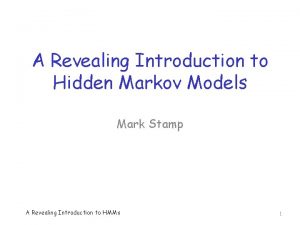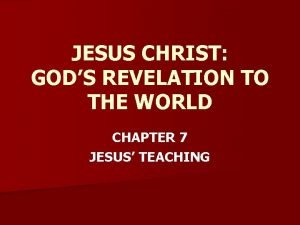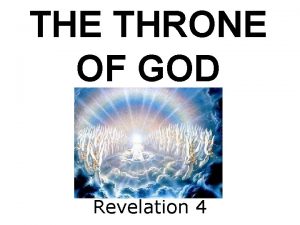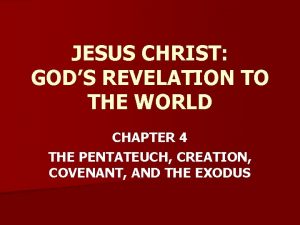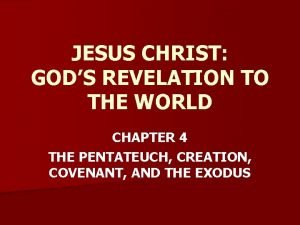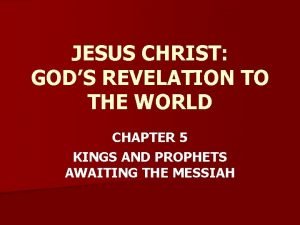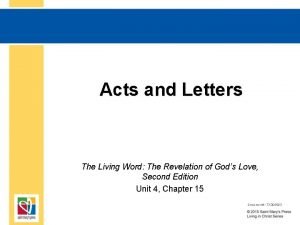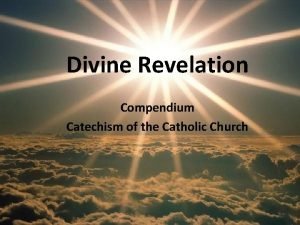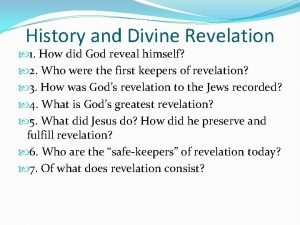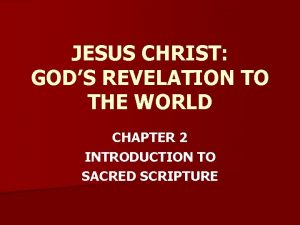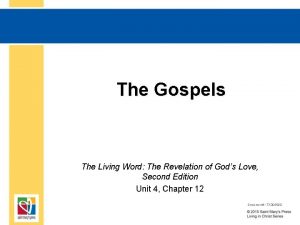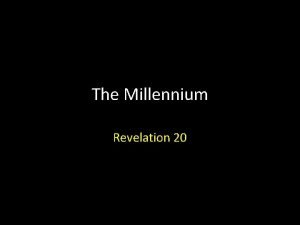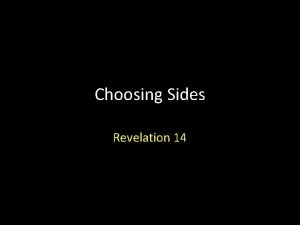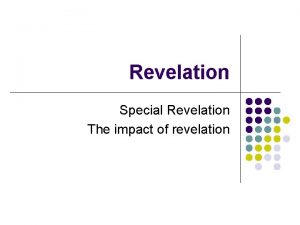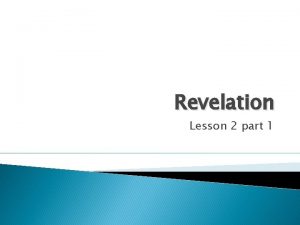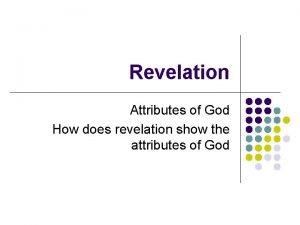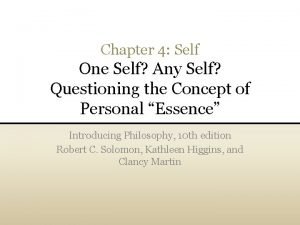REVELATION God is a self revealing God 1

















- Slides: 17


REVELATION … God is a “self revealing” God 1. In creation…general … Ps. 19: 1 -6; Rom 1: 18 2. In Jesus Christ…Heb 11: 1 -2 3. In Scripture…II Timothy 3: 15 -16 INSPIRATION … divine and human • Not “dictation” or “verbal” • Dynamic … the personality of the author is very much involved • Plenary – all of scripture is inspired Revelation … the origins of giving of truth Inspiration … the reception and recording of truth

HOW DOES GOD SPEAK? 1. A phenomenon plus a voice 2. A supernatural messenger or an angel 3. Dreams and visions 4. An audible voice 5. The human voice 6. The human spirit of the “still small voice”

INERRANT … The result of the divine-human authorship is a message without error. • If God is true (Romans 3: 4) and the Bible comes from God (2 Timothy 3: 16), then the Bible must be true in all its parts. • That is why the Bible is said to be in errant. Inerrancy is the view that when all the facts become known, they will demonstrate that the Bible in its original autographs and correctly interpreted is entirely true and never false in all that, it affirms, whether that relates to doctrine or ethics, or to the social, physical, or life sciences. " (Feinberg. . . Evangelical dictionary of theology, page 142)

UNCIAL • A style of writing popular and till the ninth century. • Characterized by all capital letters • No spaces. . . No punctuation BLESSEDARETHEPOORINSPIRITFORTHEIRSISTHEKINGDOMOFHEAVEN BLESSEDARETHOSEWHOMOURNFORTHEYSHALLBECOMFORTED BLESSEDARETHEGENTLEFORTHEYSHALLINHERITTHEEARTH BLESSEDARETHOSEWHOHUNGERANDTHIRSTFORRIGHTEOUSNESSFOR THEYSHALLBESATISFIED

MINISCULES • Small letters … All written in cursive style • Popular after the ninth century • More writing in less space blessedarethepoorinspiritfortherisisthekingdomofheaven blessedarethosewhomournfortheyshallbecomforted blessedarethegentlefortheyshallinherittheearth blessedarethosewhohungerandthirstforrighteousnessfort heyshallbesatisfied

Hebrew Form The Hebrew Bible is composed of 24 books The Jewish Bible is arranged in THREE sections They count 24 books in three sections 1. LAW 2. PROPHETS 3. WRITINGS

Greek Form Hebrew scriptures were translated into Greek at Alexandria, Egypt (250 BC - 150 BC) The Greek Translation of the Hebrew Scriptures is called the Septuagint (LXX) The Alexandrian classification became the basis for our Old Testament LAW - 5 books HISTORY - 12 books POETRY - 5 books PROPHECY - 17 books

HEBREW/GREEK DIFFERENCE Hebrew totals 24; Greek totals 39 They count differently. . . but they have the same books in both All minor prophets (12) count as one book 1 and 2 Samuel are considered one book 1 and 2 Kings are considered one book 1 and 2 Chronicles are considered one book Ezra and Nehemiah are considered one book

Latin Form The Latin form follows the Septuagint (LXX) The Latin Bible is called the Vulgate It was translated by Jerome in 383 AD - 405 AD By this time, Christendom had come to favor the Greek form - 39 books/four fold division

English Form The Latin Vulgate was the standard for 1000 years Wycliff's English Bible followed the fourfold division/39 books (1382 – 1395) All English version since have followed a similar form • Stephen Langdon, the University of Paris . . . divides the bible into chapters in 1227 • Robert Stepanus, a Paris printer adds verses in 1551 and 1555

TIMELINE OLD TESTAMENT. . . (1445 - 400 BC) Genesis (1445) Leviticus (1445) Deuteronomy (1405) Exodus (1445) Numbers (1405) Joshua (1405 -1385) Ruth (1000) 1 & 2 Kings (561 -538) Ezra (457 - 444) Esther (475) Judges (1043) 1 & 2 Samuel (1000 -900) 1 & 2 Chronicles (450 -430) Nehemiah (425)

TIMELINE OLD TESTAMENT. . . (1445 - 400 BC) Job (lived in patriarchal times) Psalms (1450 - 500) Proverbs (950) Ecclesiastes (931) Song of Solomon (960)

TIMELINE OLD TESTAMENT. . . (1445 - 400 BC) Isaiah (740) Lamentations (586) Daniel (536) Joel (830) Obadiah (845) Micah (735) Habakkuk (609) Zecheraih (520 - 518) Jeremiah (561) Ezekiel (570) Hosea (750) Amos (760) Jonah (780) Nahum (661 - 612) Zephaniah (635) Malachi (430)

TIMELINE NEW TESTAMENT. . . AD 50 to AD 100 Matthew (50) Mark (50) Luke (60 -61) John (80 - 90) Acts (63)

TIMELINE NEW TESTAMENT. . . AD 50 to AD 100 Romans (56) II Corinthians (55 -56) Ephesians (61) Colossians (61) II Thessalonians (51) II Timothy (64) Philemon (61) I Corinthians (54 -55) Galatians (48) Philippians (62) I Thessalonians (51) I Timothy (62) Titus (63)

TIMELINE NEW TESTAMENT. . . AD 50 to AD 100 Hebrews (65) I Peter (65) I John (85) III John (90) Revelation (95) James (45) II Peter (67) II John (90) Jude (70)
 Self and ideal self
Self and ideal self Yehuda lindell
Yehuda lindell The ocean floor revealing plate tectonics
The ocean floor revealing plate tectonics A revealing introduction to hidden markov models
A revealing introduction to hidden markov models A revealing introduction to hidden markov models
A revealing introduction to hidden markov models Order revealing encryption
Order revealing encryption Tru face revealing gel
Tru face revealing gel Jesus christ god's revelation to the world
Jesus christ god's revelation to the world Sardine stone
Sardine stone Jesus christ god's revelation to the world
Jesus christ god's revelation to the world Jesus christ god's revelation to the world
Jesus christ god's revelation to the world Jesus christ god's revelation to the world chapter 5
Jesus christ god's revelation to the world chapter 5 The living word the revelation of god's love
The living word the revelation of god's love Optimo global group inc
Optimo global group inc Jesus christ god's revelation to the world answers
Jesus christ god's revelation to the world answers Who is the protector and teacher of god's revelation
Who is the protector and teacher of god's revelation Jesus christ god's revelation to the world
Jesus christ god's revelation to the world The living word the revelation of god's love
The living word the revelation of god's love




